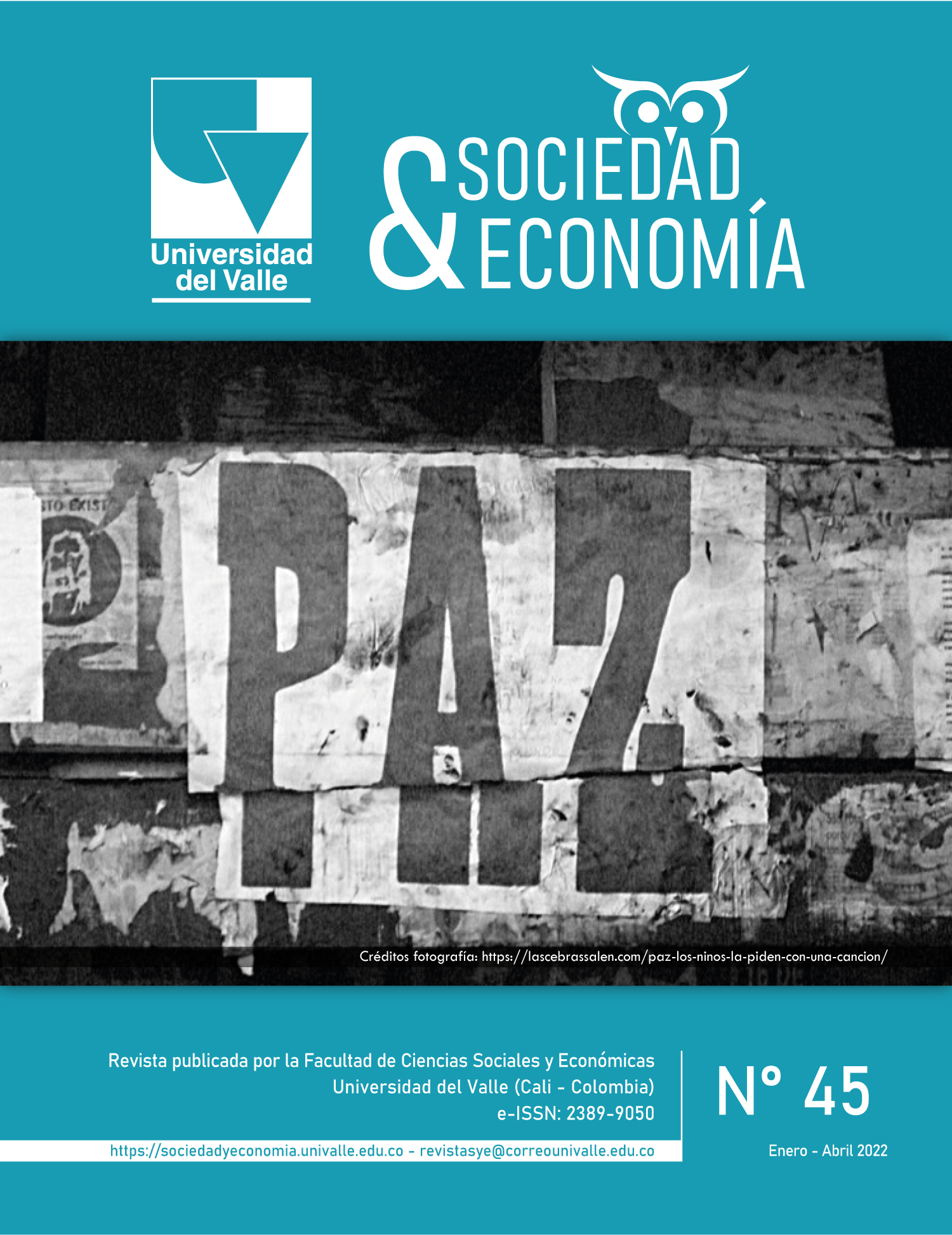Inhabiting the sinkhole?: Urban mining and environmental social mobilization in Soacha
Main Article Content
This article deals with two cases of urban communities neighboring mining projects in the municipality of Soacha and its main objective is to understand how mobilization against mining arises in these communities. For this reason, the situation in which the mobilization exercise is carried out is compared with the situation in which the mobilization exercise is not carried out. All these cases are adjacent to the mining area of the city, have a similar socioeconomic composition, and use information obtained from documents and interviews to analyze the timeliness of the two using qualitative comparison methods. Two factors have been found to explain the emergence of mobilization: On the one hand, the existence of an administration that constitutes political opportunities that are perceived as such. On the other hand, the appropriation of institutionalized organizational space plus organizational alliances.
- urban mining
- social movements
- environmental organizations
- marginality
Alcaldía Municipal de Soacha y Universidad Externado de Colombia. (2009). Perfil Ambiental Municipal: Visión Comunitaria. Alcaldía Municipal de Soacha.
Álvarez-Rivadulla, M. J. (2019). Política en los márgenes. Asentamientos irregulares en Montevideo. Ediciones Uniandes.
Auyero, J. y Swistun, D. (2007). Expuestos y confundidos. Un relato etnográfico sobre sufrimiento ambiental. Íconos - Revista de Ciencias Sociales, (28), 137-152. https://doi.org/10.17141/iconos.28.2007.216
Auyero, J., Hernández, M. y Stitt, M. E. (2019). En el vientre de la bestia. Reconstrucción relacional de la campaña contra el fracking en Texas. Estudios sociológicos, XXXVII(111), 611-657. https://doi. org/10.24201/es.2019v37n111.1789
Bebbington, A. (Ed.). (2007). Minería, movimientos sociales y respuestas campesinas. Una ecología política de transformaciones territoriales. IEP-CEPES.
Caracol Radio. (2016, 16 de noviembre). CAR impone la sanción económica más alta de la historia por explotación minera. https://caracol.com.co/emisora/2016/12/23/bogota/1482533220_447678.html
Comité de seguimiento para la agenda ciudadana sobre el impacto de la minería. (2008). Impacto socioambiental de la explotación minera en el municipio de Soacha. Contraloría General de la Nación.
Conde, M. y Le-Billon, P. (2017). Why do some communities resist mining projects while others do not? The Extractive Industries and Society, 4(3), 681-697. https://doi.org/10.1016/j.exis.2017.04.009
Cushing, L., Morello-Frosch, R., Wander, M. y Pastor, M. (2015). The Haves, the Have-Nots, and the Health of Everyone: The Relationship Between Social Inequality and Environmental Quality. The Annual Review of Public Health, 36(194), 193-209. https://doi.org/10.1146/annurev-publhealth-031914-122646
Davidov, V. (2013). Mining versus oil extraction: Divergent and differentiated environmental subjectivities in “post-neoliberal” Ecuador. The Journal of Latin American and Caribbean Anthropology, 18(3), 485-504. https://doi.org/10.1111/jlca.12043
El Tiempo. (2016, 24 de diciembre). CAR impone millonaria multa por actividad minera en el sur. https:// www.eltiempo.com/bogota/un-privado-debera-pagar-siete-mil-millones-de-pesos-la-multa-mas-alta-en- la-historia-de-la-entidad-48552
Ferguson, J. (1999). Expectations of Modernity: Myths and Meanings of Urban Life on the Zambian Copperbelt (1a ed.). University of California Press. https://www.jstor.org/stable/10.1525/j.ctt1ppm82
Foyer, J. y Doumolin-Kevran, D. (2017). ¿Ambientalismo de las ONG versus ambientalismo de los pobres? En P. Almeida y A. Cordero-Ulate (Eds.), Movimientos sociales en América Latina. Perspectivas, tendencias y casos (pp. 391-412). CLACSO.
Fry, M. (2011). From Crops to Concrete: Urbanization, Deagriculturalization, and Construction Material Mining in Central Mexico. Annals of The Association of American Geographers - ANN ASSN AMER GEOGR, 101(6), 1285-1306. https://doi.org/10.1080/00045608.2011.584289
Goodwin, J. y Jasper, J. M. (1999). Caught in a Winding, Snarling Vine: The Structural Bias of Political Process Theory. Sociological Forum, 14(1), 27-54. https://doi.org/10.1023/A:1021684610881
Hernández, M. (2019). Building a Home: Everyday Placemaking in a Toxic Neighborhood. Sociological Perspectives, 62(5), 709-727. https://doi.org/10.1177/0731121419866806
Himley, M. (2014). Mining History: Mobilizing the Past in Struggles over Mineral Extraction in Peru. Geographical Review, 104(2), 174-191. https://doi.org/10.1111/j.1931-0846.2014.12016.x
Inclán, M. (2017). Oportunidades como puertas corredizas: Los zapatistas y su ciclo de protestas. En P. Almeida y A. Cordero-Ulate (Eds.), Movimientos sociales en América Latina. Perspectivas, tendencias y casos (pp. 259-292). CLACSO.
Klandermans, B. (2015). Motivations to Action. En D. Della-Porta y M. Diani (Eds.), The Oxford Handbook of Social Movements (s.p.). Oxford University Press [Online Publication]. https://doi.org/10.1093/ oxfordhb/9780199678402.013.30
Lapegna, P. (2016). Soybeans and Power: Genetically Modified Crops, Environmental Politics, and Social Movements in Argentina (1a ed.). Oxford University Press.
McAdam, D., Tarrow, S. y Tilly, C. (2001). Dynamics of Contention. Cambridge University Press.
McAdam, D. y Boudet, H. (2012). Putting Social Movements in their Place: Explaining Opposition to Energy Projects in the United States, 2000-2005. Cambridge University Press. https://doi.org/10.1017/ CBO9781139105811
Pellow, D. (2002). Garbage wars: The struggle for environmental justice in Chicago. MIT Press.
Pellow, D. y Nyseth-Brehm, H. (2013). An Environmental Sociology for the Twenty-First Century. The Annual Review of Sociology, 39, 229-250. https://doi.org/10.1146/annurev-soc-071312-145558
Pino, A. P. y Carrasco, N. G. (2019). Extractivismo forestal en la comuna de Arauco (Chile): internalización y formas de resistencia. Rev. Colomb. Soc., 42(1), 207-226. https://doi.org/10.15446/rcs.v42n1.73233 Ragin, C. (1987). The Comparative Method. Moving Beyond Qualitative and Quantitative Strategies. University of California Press.
Roca-Servat, D. (2012). Unveiling Water (In) Justice in Arequipa: A Case Study of Mining Industry in Urban Space. Arizona State University. http://hdl.handle.net/2286/R.I.15188
Rueda-García, N., Sáenz, L. H., Álvarez-Rivadulla, M. J., Bocarejo, D., Acevedo, J., Velásquez, J. M. y Bocarejo, J. P. (2012). El Cazucable de Soacha: ¿Una idea excéntrica? En J. Dávila (Ed.), Movilidad y pobreza urbana. Aprendizajes de Medellín y Soacha (pp. 120-149). The Development Planning Unit; Universidad Nacional de Colombia.
Sampson, R. J., McAdam, D., MacIndoe, H. y Weffer-Elizondo, S. (2005). Civil Society Reconsidered: The Durable Nature and Community Structure of Collective Civic Action. American Journal of Sociology, 111(3), 673-714. https://doi.org/10.1086/497351
Tarrow, S. (1994). Power in Movement. Social Movements and Contentious Politics. Cambridge University Press.
Vega-Centeno, P. (2011). Los efectos urbanos de la minería en el Perú: del modelo de Cerro de Pasco y La Oroya al de Cajamarca. Apuntes. Revista De Ciencias Sociales, 38(68), 109-136. https://doi.org/https:// doi.org/10.21678/apuntes.68.621
Widener, P. (2011). Oil Injustice: Resisting and Conceding a Pipeline in Ecuador. Rowman & Littlefield.
Downloads

This work is licensed under a Creative Commons Attribution-NonCommercial 4.0 International License.
Revista sociedad y economía editada por la Facultad de Ciencias Sociales y Económicas de la Universidad del Valle se encuentra bajo una Licencia Internacional Creative Commons Atribución - No comercial 4.0
Basada en una obra en http://sociedadyeconomia.univalle.edu.co





